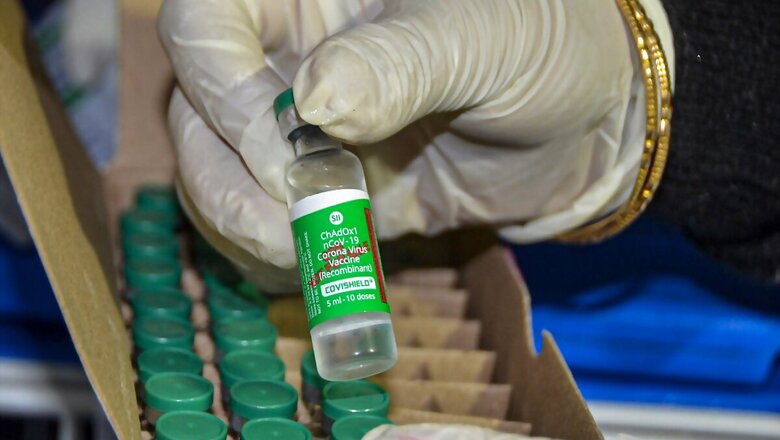
views
Even as India witnesses an unprecedented surge in COVID-19 infections, the country is also gearing up for the next phase of vaccination wherein anyone above 18 years of age will be eligible to take the jab from May 1. News18.com speaks to scientist Virander Singh Chauhan, currently associated with the International Centre for Genetic Engineering and Biotechnology, on logistical challenges, key learnings and what India can do better now.
As the government opens up vaccination for everyone above 18 years of age from May 1, what are the logistical challenges we can expect?
Even if you have large number of vaccine centres, you still need vaccines to inject in people’s arms. While we have been saying that we can import vaccines and the government has waived customs duty on COVID-19 vaccines, the question is which vaccines would be available. Both Moderna and Pfizer vaccines have been overbooked. Even if we want to buy from them, the vaccines cannot be available in the market overnight. Dr Reddy’s Laboratories plans to manufacture 500 million doses of the Sputnik V vaccine, but that is when the production begins in Hyderabad. So, in May, I don’t see too many vaccines hitting the market. The demand-supply balance would heavily tilt towards the demand side.
How exactly will states procure vaccines from manufacturers?
In every country, the central government procures the vaccines directly from the manufacturers and then distributes it. In India, the argument was that one must avoid any possible slowdown in vaccination due to bureaucratic hassle, and therefore, states have been allowed to procure directly from the manufacturers.
Big hospitals with chains might actually find it easier to directly procure from the manufacturers since they have been doing it in the past. Let’s wait till May 1 to see how this pans out. Will states queue up, will there be a rush in front of these two companies (Serum Institute and Bharat Biotech), or will some states directly import vaccines (Sputnik V) from Russia?
Have vaccine hesitancy and vaccine wastage affected the first two phases of rollout?
Naturally, yes. However, if there were more than enough vaccines and still the population did not get vaccinated, then vaccine hesitancy would play a very important role. In India’s case, I don’t think we can say that vaccine hesitancy has contributed to low rate of vaccination.
In India, even with vaccine hesitancy, there will be more than enough people who will line up to take the vaccine. The hesitancy will possibly come into play post August-September, and that hesitancy has been seen all over the world. In India, in general, vaccine hesitancy is less, compared to some other advanced countries.
What have been the key learnings from the first two phases of rollout and what can we do better this time?
We didn’t gear up to produce more vaccines, especially when we have tremendous potential. It is not clear why we waited. I had said it as early as August-September last year that India would be the major hub of vaccine production for COVID-19.
The horror story that we are now witnessing across India has not reached its climax yet. Vaccination and partial lockdown are key to breaking the cycle of transmission. Vaccination, especially for a country like India, would have been a great golden chance, but we did not start vaccinating people until March (60 and above).
This wave, after killing thousands of people, will pass. But, we must prepare for the third wave. It would be silly to think there won’t be a third wave, and the best way to confront it would be to vaccinate as many people as possible.
Also, we could have given out good, quality messages on wearing mask, not stepping out unless needed and staying away from big gatherings.
Why has this wave been more severe than the one we saw last year? What has changed? Why do more people need hospitalisation this time?
The mutants that have emerged are fitter than the original Wuhan virus. Fitter in this case would mean they multiply faster and are more infective.
Science has not established this yet, but this virus does seem to infect younger people much more than it did earlier, which could be an indication that the virus is changing its behaviour. Wuhan virus hardly touched children or young people. This time, people in their 20s and 30s are getting infected and have to go to hospital, although more deaths have been reported in the above-45-50 age bracket.
Having said that, the second wave was inevitable. The notion that one cannot get infected by the virus after getting attacked once and that we are ‘naturally protected’ given the unhygienic conditions we live in gave us a false sense of security.
With more vaccines expected to be available over the next few months, do you think things will stabilize and we would have developed herd immunity by July-August?
By first week of June, you may see production of vaccines doubling. Vaccines are given to healthy individuals; therefore, at no point can the quality get affected. Vaccine production requires careful and cautious batch-to-batch quality control. It cannot be done hastily. By mid-June and early July, I would imagine we will have sufficient supply of vaccines and would be in a happier position.
For herd immunity, we need to immunize at least 60 per cent of the population, which would be nearly 80 crore people. If we exclude Johnson & Johnson vaccine from our calculation, we still need 160 crore doses of the vaccine (assuming these are double dose vaccines). So far, we have administered 14 crore doses. Even in a best-case scenario, we can achieve our target between October and December. Otherwise, we will go well into 2022 before we can achieve herd immunity.
How much the virus will mutate and how many will escape immunity by then, nobody can answer these questions right now. In the battle between humans and the virus, it is a struggle for survival for both. And, this battle has no clear winner, as of now.
Read all the Latest News, Breaking News and Coronavirus News here. Follow us on Facebook, Twitter and Telegram.




















Comments
0 comment